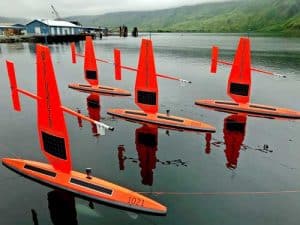
We’ve launched
The end of June, four Saildrones left Dutch Harbor, AK and headed north. These ocean-going robots have started to carry out a 700-nautical-mile trip to Bering Strait, where they will enter the Chukchi Sea and begin their work in the Chukchi and Beaufort Seas, and the Arctic Ocean. NOAA Fisheries scientists at the Alaska Fisheries Science Center are using two of these Saildrones to measure the abundance of Arctic cod in Alaska. The other two are being used by NOAA Research’s Pacific Marine Environmental Laboratory to observe how the Arctic Ocean is absorbing carbon dioxide from the atmosphere.
How the Saildrone Works
The Saildrone is an autonomous vehicle, which uses wind for propulsion and generates electricity with solar cells. Standing 16 ft tall and 22 ft long, they carry a broad range of sensors that measure weather conditions (e.g. wind, barometric pressure, sunlight, air temperature) in the air, and water properties (e.g. temperature, salinity, oxygen, phytoplankton).
We receive measurements via satellite transmissions, so we can monitor and respond to what the Saildrones see. We can turn instruments on and off or even change where the Saildrones go. Because the Saildrones are operated remotely and use only the wind and sun for power, they are great platforms for working in very remote regions such as the Alaska Arctic. They can travel to these isolated areas under their own power, stay at sea for many months, and cover a lot of ground. Surprisingly little is known about these Arctic ecosystems, in large part because they are remote and it’s costly to work there.
In 2016 and 2017, we worked with a team that installed echosounders (fishfinders) on Saildrones and deployed them in the Bering Sea to measure the abundance of fish in an area where fur seals feed. The echosounder measures fish by transmitting a sound pulse and measuring the sound waves echoing back from fish in the water. By making repeated measurements as it moves through an area, the Saildrone can map the abundance of fish. It is difficult to distinguish different species and sizes of fish with the echosounder, so this works best in areas like the Arctic, where a single species and size of fish dominates fish populations in the water.
Understanding More About Arctic Cod
We are using echosounders on two of the Saildrones heading to the Arctic this year to determine the amount and distribution of Arctic cod, a fish that just about everything in Arctic waters eats; species of seals, whales, and seabirds depend on them.
One of the main things we’re trying to do is repeat a ship-based survey over the Chukchi Sea that we have been conducting in recent years. What we have learned from this and other work in the area is that there are very high abundances of young Arctic cod about two inches long (i.e. their first year of life) in the Chukchi Sea, but few adults in the area.
We are trying to understand whether this area serves as a nursery ground, with these fish migrating to other areas in the Arctic, or whether these fish don’t survive the winter.
Additionally, we know that the environment these fish are living in is undergoing rapid change. Temperatures have increased substantially. The amount and duration of sea ice has decreased. But, we don’t know how this will affect the Arctic cod.
The work this year will add another year of observations to help us understand the impact of the changing environment on the distribution of these fish.
Since they were launched on June 30, the Saildrones have already made it about 100 nautical miles into their journey, ready to start three months of science in the Arctic.
Source: NOAA
